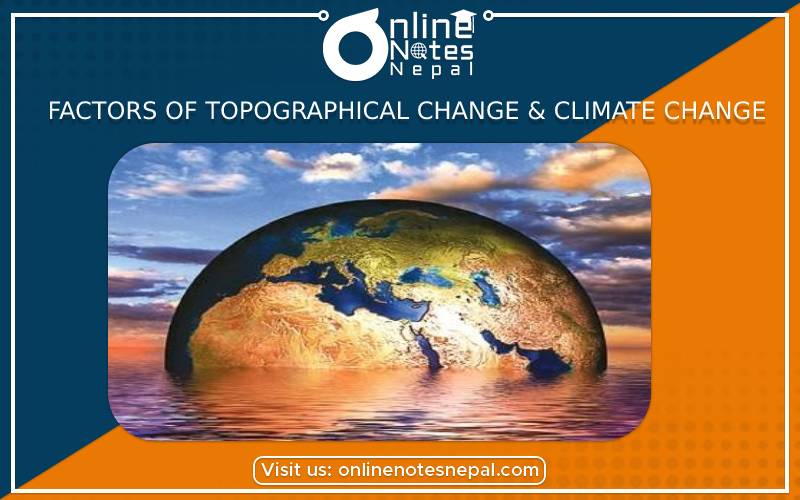Published by: Nuru
Published date: 25 Jan 2022

In this topic Factors of Topographical Change & Climate Change, we describe the factors affecting topographies or earth's surfaces, and climate changes.
Topography is the configuration of the earth's surface including its relief and the positions of its natural and man-made features. Earth has uneven surfaces which differ from place to place. It consists of valleys, mountains, plains, foothills, basins, etc., and all these varied land structures are called topography. It is the opposite of weather, which is always changing.
Our earth consists of two components, namely, land and water. They are called continents and oceans respectively. Landmass covers nearly 29% and water mass covers nearly 71% of the total earth's surface. Mountains, valleys, gorges, lakes, rivers, plains, and landforms are the parts of the earth's surface, which is simply known as in aggregate as topography.\
This topography is divided into seven continents namely:
The topography of the earth is known as the 'local history' of earth. It is to determine the position of any features or more generally any points like lands forms, longitudes, latitudes, etc. of earth. The topography of the earth goes on changing from time to time.
There are mainly two factors that change the topography of the earth's surface. They are internal factors and external factors.
Internal Factors
The interior forces that cause changes in the earth's surface are known as internal factors. They are active beneath the earth's surface and cause changes in the crust of the earth's surface. It can bring changes in a very short period of time because of its abrupt nature. For example, earthquakes and volcanic eruptions which are originated under the earth's surface.
External Factors
External factors are the processes external to the earth's surface. It brings changes on the earth's surface externally which is continuously active on the earth's surface. Rivers, glacial currents, waves, rainfall, living beings, etc. are some of the examples of external factors that bring changes to the earth's surface. It appears after a period of time with erosion, transportation, and deposition processes. Due to these effects, landforms change into plates, U and I shape valleys, small hills, etc.
The change in the weather patterns and atmospheric temperature is known as climate change. It is also known as Global Warming. Scientists believe that the earth is currently facing a period of rapid warming brought on by rising levels of heat-trapping gases, also known as greenhouse gases in the atmosphere.
Greenhouse effects are effects of the gases or energy received from the outer atmosphere in the form of light inside the earth's surface emitting infrared radiations. With more greenhouse gases mixed in the air, the atmosphere acts like a thickening blanket and traps more heat. It has been making the earth hotter and hotter day by day.
Effects of Climate Change are as follows:
The earth’s climate nowadays is changing very rapidly and differently. Climate change in the world can be caused by various activities. When climate change occurs, the temperature rises and many different changes can occur on the earth. Some of the measurable effects are mentioned below:
Controlling Measures are as follows:
There are various measures to control climate change. Some of them are given below:
It is our duty and responsibility to solve these types of problems in the world. Time has come to think about the excessive use of natural sources and the rapid growth of industries and urbanization. As a result, developing countries like ours which have an insignificant role in carbon emission is suffering from the adverse effects of climate change. It is an alarm to the world indicating that our survival on earth is at risk due to the rising temperature of the earth.